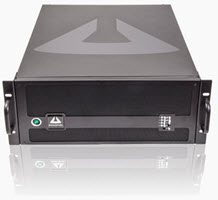In this week’s Sponsored Post, Katie (Garrison) Rivera of One Stop Systems explains high performance virtual computers for graphics intensive applications.

Katie (Garrison) Rivera, Marketing Communications, One Stop Solutions
Many industries deploy graphics-intensive applications on single user workstations with individual GPU resources. For those who have switched to a virtualization based environment, many of the legacy desktop virtualization platforms can’t support high end GPUs or multiple GPU configurations. Together with partners like Cisco and One Stop Systems, a London-based tech start-up ebb3 has created the High Performance Virtual Computer (HPVC) to tackle this issue with the aim of creating the fastest performing solution in the world.
The HPVC is a hybrid cloud based platform for graphical software, enabling multiple professionals to collaborate remotely over long distances and on any device. In addition to the increased flexibility and productivity that remote access to workstations provides, the HPVC outperforms many physical workstations in specification, while saving businesses an average of 40% in maintenance costs compared to traditional workstations. While physical workstations allow a single user to access 3D graphical applications, the HPVC provides access for an unlimited number of users at any one time.
A key component in the infrastructure of the HPVC, Cisco’s Unified Computing System (UCS) provides a foundation for virtualized graphics workstation deployment. One Stop Systems’ GPU acceleration appliance, the ExpressBox 3600 (EB3600) integrates into ebb3’s HPVC. The EB3600 provides exceptional server and workstation grade GPUs and other HPC peripheral expansion beyond what existing host computer systems can deploy inside the workstation today. Designed to support full Gen 3 x16 PCIe connectivity to all devices, the EB3600 supports up to 512 Gbps communication between the host and peripherals. The HPVC utilizes the EB3600 with four NVIDIA GRID M60 8GB graphics cards for scalable optimum performance. NVIDIA GRID technology allows a virtual desktop to access a dedicated GPU or virtualized GPU depending on the requirements of the specific application.
The HPVC is built on industry standard platforms from Cisco, One Stop Systems, NetApp, NVIDIA, Citrix and VMware. It is used in industries ranging from Oil & Gas, Design & Engineering to Geophysical and Medical Imaging. The HPVC supports applications such as Petrel, Autodesk AutoCAD, Ersi ArcGIS Pro and 3D Slicer. One Stop Systems demonstrated a video demo of many of these applications at GTC Europe in September, while ebb3 demonstrated the solution in real time.
The HPVC has already been used to run these applications for these specific industries and more. Medical professionals have utilized the HPVC to review MRI scans in 3D to improve accuracy during surgery. TESLA Motors used the HPVC running Autodesk software to design the Model S car. By allowing applications and data to be accessible anywhere and anytime, the ebb3 solution has the capability to operate over distance, without the time lag that many workstation users experience.
The HPVC also provides a data storage aspect so the solution can be truly mobile. It also helps keep clients’ valuable datasets inside the datacenter where they are protected and secure and also provides massive performance benefits as the applications are running right next to the data. ebb3 designed the HPVC to be many times more powerful than any physical workstation, supporting multiple operating systems running simultaneously on multiple devices with the ability to add user profiles speedily, as well as driving multiple 4x4k screens within minutes. With help from One Stop System’s GPU acceleration appliance and hardware and software from many industry leaders, the HPVC delivers extreme performance for 3D and graphically intensive workloads.
This guest article was submitted by Katie (Garrison) Rivera, Marketing Communications at One Stop Systems




